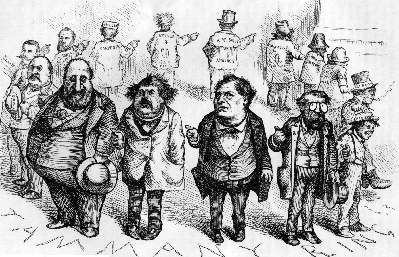Somewhere between 13 and 22 seconds after the first offering of free content on the Web, the publisher asked herself, “How am I going to pay for this?”. And web publishers have been asking that question ever since. The current economic meltdown makes it a more urgent question, but it’s always been there. We sum it up in a slogan: this service is free, but it is not costless. We spend a lot of time and effort trying to resolve that conflict between our aspirations and the need to buy groceries.
The open-access-to-law community (particularly in the US) has had trouble with this. There are a variety of solutions, few if any complete in themselves. Most open-access providers originally depended — as we have — on grant funding, and on extensive support from a parent institution or a consortium. Most have added consulting income to the mix. And many get income from commercial partnerships, often based on the sale of back-end bulk data services. The most stable model is CanLII‘s, which is financed by a head tax on Canadian lawyers. An excellent paper by Graham Greenleaf (abstract here, slides here), offered at the recent Law via the Internet conference in Florence, describes one prominent free-access provider’s experience in keeping the doors open.
In any case, open access to law presents some unusual sustainability problems. And those problems vary a lot from place to place. Institutional and political settings are very different, particularly in transition countries ( no doubt some of our problems here at the LII would no doubt be seen as high-quality problems by others). Here’s a brief catalog — full treatment would need a very long article indeed:
First, open-access providers don’t really do research, in the sense of either basic science, or quantitative social science, or any of the things funded by research-oriented outfits like the NSF. We can sometimes make a plausible case for ourselves as testbeds or helpers on grants that go to others (as the LII has with its participation in the CeRI project).
Second, we are continually faced with rising costs of innovation. The new legal information products and services we imagine, and hope to build, are significantly more expensive to produce than the things we imagined when we began 16 years ago. This is partly the result of the Web’s technical evolution and partly the result of more sophisticated needs and wants — a slow but steady revolution of rising expectations that we share with our users. In 1993, we could significantly raise the sights of everyone in the legal information world by spending a snowy afternoon putting Two Pesos v. Taco Cabana into HTML — a one-person task that created the first web-published judicial opinion. These days, it takes many more people a lot longer to come up with something that interesting and useful.
Like other not-for-profit projects, we have more trouble finding operating money than we do finding startup funds. A lot of people would like to see their law (or someone else’s) put online. Very few are willing to pay to maintain it. This is a particular problem with legislation, which requires frequent updating. It also distinguishes legislation and regulations from scholarly publishing, and from many open-access repositories, which (like judicial opinions) gather material that is relatively static once mounted.
Some deep-rooted reluctance surrounds the funding of legal information, perhaps based on the idea that free legal information is just lawyer subsidy, or only answers the information problems of the rich (as Dan Dabney once put it). Who wants to feed the sharks?
Open-access providers could do more than they have to dispel this distrust. For the most part, we’ve made the case for open access in highfalutin’ normative terms: support the rule of law, level the playing field for human rights, force the state to meet the transparency/publishing obligations implied by the idea that ignorance of the law is no excuse. That’s a regime where success is hard to measure, if only because assessment is often self-referential. We declare our results to be good because our intentions are noble. We are Doing the Right Thing, and who would question that? We are now starting to see some work on evaluation of open access in much more hardheaded terms — how does it contribute to lawyer competence, support economic development, level the playing field between one-shot litigants and repeat players? These are important questions that will, if we are able to answer them rigorously, provide us with a strong case for support.
 And then there is the “Tweed Ring” challenge — illustrated handsomely by this Thomas Nast cartoon. Everybody thinks that free legal information is the next guy’s problem. Private foundations think government should do it. Government thinks that it is doing it (via weak services like PACER), and that anything it isn’t doing must be some kind of value-added service that the legal profession should pay for, or a matter of interest only to academic researchers. The legal profession would like to pass research costs on to the clients, and increasingly can’t (small and solo law offices probably never could). And so on.
And then there is the “Tweed Ring” challenge — illustrated handsomely by this Thomas Nast cartoon. Everybody thinks that free legal information is the next guy’s problem. Private foundations think government should do it. Government thinks that it is doing it (via weak services like PACER), and that anything it isn’t doing must be some kind of value-added service that the legal profession should pay for, or a matter of interest only to academic researchers. The legal profession would like to pass research costs on to the clients, and increasingly can’t (small and solo law offices probably never could). And so on.
Nobody thinks that free legal information is a bad thing, or unworthy. It’s just not at the top of anyone’s list. The US is a particularly severe case because (unlike the countries of the European Union, where partnerships like ITTIG are fairly common) we have never thought that work in legal information was a matter for cooperation between government and academia. Partnerships have been almost exclusively with private industry, though private industry sometimes relied on basic research produced by information scientists.
This circle may break soon. Government transparency-by-web will no doubt get a lot of attention from the new administration; expectations among the “hack-the-gov” crowd are already very high, and there is good reason for this optimism. We are seeing what amount to open-access legal information projects of this kind demanded by assessments like the recent ABA committee report on e-rulemaking and realized in the efforts of people like the Sunlight Foundation (GovTrack.us is a good example). And certainly the economic crisis is pushing us toward greater awareness of global interdependency and with it the need for global transparency of regulatory and other legal regimes.
At the LII, we are moving toward sustainable self-support; we’re not there yet. We get about 20% of our current budget from the generous contributions of private individuals who think we’re worthwhile (and if you’re one of them, let me thank you again on behalf of all six of us here). We recently added Google ads to many of our pages; we’re seeking sponsors for others. And this week marks the launch of a new service offered in partnership with our friends at Justia.com : a lawyer directory service that offers great value, and an opportunity for us to give reciprocal benefits to those who help us out either financially or with donations of their expertise in the form of wiki content and other things that benefit our audience.
We have great hopes for it. Talk it up.
[ Guilt-inspired author note: apologies for the long absence. It’s been an unusually busy six or seven months, even by LII standards. With luck, this will be the first in a series of posts reporting on what I’ve seen and learned in that time.]





 That profession, whose leading light
That profession, whose leading light 